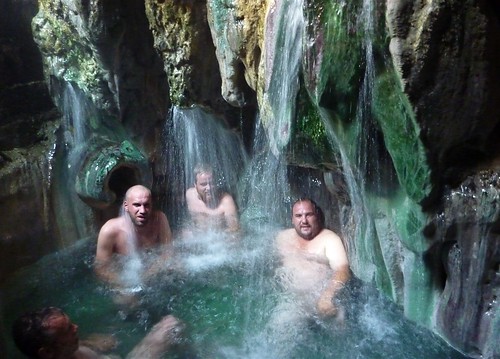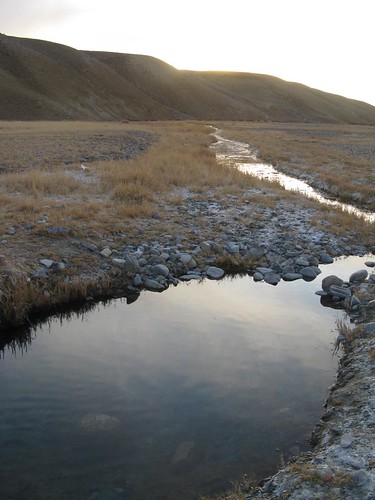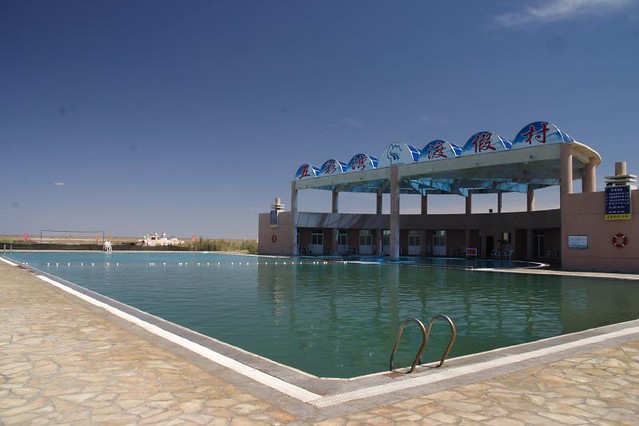While discussing hot springs in Kyrgyzstan it's easy to confuse this with political affairs. And certainly the humanitarian state of this country is in dire straits. My sympathy goes out to all those fleeing bigotry and hatred.
Bigger picture
But I still would like to concentrate on hot springs as in geothermality. In this blog most of my postings have been highlighting the naturalness of the hot springs or the naturality of the soaking experience itself. However in Kyrgystan the opposite is also well-known. Soviet times saw grander schemes to develop naturally occurring thermal water into workers paradises, the sanatoriums. Since the collapse of the workers pie-in-the-sky these places have been neglected and in some cases are turning into ruins.
What to think of this (geographic unclear) sanatorium experience?
'I am sitting in the outdoor hot spring pool of the Sanatorium At The End Of The Universe. The tiles are chipped and the water is murky. But, I’ve been assured by my local friend, “don’t worry, the water is changed at least once a week. Anyway, the U.S. military guys came down and did tests. They said the water was fine, but men shouldn’t soak for more than 15 minutes.” What about women, I ask. She shrugs. So I soak a little longer'.Despite the chipped tiles, this internet reference clearly establishes that the Kyrgyz like soaking. From things the Kyrgyz love:
'Hot Spring Baths – This seems to be a universally healthy thing around the world. What you use it to treat depends on the chemical make-up of each individual spring. The hot springs we went to, Bar Bulak (lit. trans. Fire Spring), had a high sulfur and iron content and according to the sign posted on the wall of the spa it can be used to treat, “Problems of the Skin and the Digestion, Also Useful for Treating Women’s Problems”.For the insane?
It actually was quite stimulating and our skin was very healthy for the following month. But you have to be careful about which spring you bathe in. Near Kara Kol, one of the more popular springs has Radon in the water'.
Sanatoria are located in
- Jalalabad, also known as Kochkor-Ata:
'While in Osh I made a daytrip to Jalalabad where they had a thermal hot spring with sanatorium. I say had as most of the buildings where in ruins and the only hot spring water I saw came from a tap where you had to pay for drinking it'.
'Djalal-Abad is famous for its spas. There is a legend that the water from the Hozret-Ayub-Paigambar spa cured lepers. According to the legend there was a grave, a mosque and the khan's palace near the spa. The Djalal Abad sanatoria, “Kurort”, is based on one of the spas on one of the hills overlooking the town – the waters are salty, but people from a wide area to collect bottles of it. Near the entrance to the Kurort (the health resort) is a cafe with a fine view over the town – the "Ikram-Ajy" Panorama, at a height of 1000 meters , with a complex that consists of a “national crafts hall”, souvenir shop and an entertainment hall –from here you can appreciate how green the city is, as the trees rise above the low-rise building. The spas are also the source for several different brands of mineral water'. (source)- Ak Suu. There are some photo's of the slowly deteriorating sanatorium as well as other photo's here. Then's there is this:
'For those with too little time to visit Altyn Arashan this is an opportunity to bathe in natural hot springs. The waters are said to have healing properties curing everything from insomnia to rheumatism. Al-Suu's sanatorium 7 km from Karakol is set in a pretty gorge and has numerous relaxing bathhouses. Local people come here at weekends to wallow in the waters, chat and ramble through the gorge. The village of Ak Suu close has plenty of attractive wooden cottages, a Orthodox church and shops where you can stock up on traditional post-bath bread, fish, vodka and beer.- Issyk Ata, also known as Dzuuku or as its translation of warm father (source)! This combines a sanatorium with the existence of public baths. Immediately the web entries are a lot more positive.
It is located on the north slope of Terskey Ala-Too chain in a narrow gorge in Ak-Suu river valley at an altitude of 1950m above sea level in a distance of 16 km from Karakol town. It works all year. The curative spring water wells have been known since the ancient times. A bath and 2 rooms were built in 1896. Since 1957 the sanatorium works as children hospital. The climate of resort is highland. A non-polluted air, ultraviolet rays create appropriate conditions for climate therapy. In the winter the temperature extends to -17C, in the summer the temperature is 20-25C. The general curative factor is mineral water, nitrogen thermal water (till 60C) sulfate-chloride-sodium water with weak mineralization, consists of silicon, acidy fluorine, free sulfur-hydrogen and small quantity of radon.
The sanatorium takes in some patients with child cerebal paralysis, consequences og meningitis, myletis, polymyletis, neuritis, cranium-brain traumas, skin ailments supporting-motion system and etc.
In the summer time there are 3 pavilions, in the winter -1. The capacity is 250 positions. The term of treatment for mothers with children from 1 to 3 years old is 45 days, children from 4 to 14 years old – 60 days.
In the 3 story building there are massage and procedure room sport hall, physiotherapy room, bath department, swimming pool, playing rooms, chambers, kitchen, library, school. The bathes curative exercises mechanic therapy massage and etc. are applied for treatment'.
'Don't know if it is because of the altitude (nearly1800 meters) but I was feeling little strange there in Issyk Ata. This hot spring water spot situated at less than 2 hours from Bishkek was not only smelling the sulfur of its bathes but also something like a soviet perfume. Ok maybe I was sad because not so many chaikhanas up there!'.An other visitor says though somewhat rudimentary facilities it does have good views. There's a big waterfall nearby.
-
'Not far up the valley is the Djety Orguz sanatoria built in and the sight of the first meeting between Presidents Akayev and Yelsin in 1991 after the abortive coup in Moscow'. (source)This reference also claims that there are more than 50 hot springs in Kyrgyzstan though only lists 4 ...
- Bar Bulak:
'Really its not that bad. Its only the iron in the water. The springs are said to be very useful to the health. We can actually see some improvement in the quality of our skin'.Possibly this is a reference to the same sanatorium as others under names such as Issyk Kul. The lake of Issyk Kul is quite unique as ice never forms.
'It is fed by springs including many hot springs and snow melt-off'.This according to wikipedia.
As nature intends
But then there is the soakers paradise of Altyn Arashan, also known as Teplokluenchka, Golden Spa, Ak Suu and/or Karakol. Teplokluenchka is actually Russian for hot springs; since, the village name has been referred to Ak Suu. However in reality there is no village and Ak Suu is used as reference to the sanatorium referred to above.
Altyn Arashan is by far the most photographed (photo of 'heaven') and experiences-shared hot spring in Kyrgyzstan.
'The Altyn Arashan ("Golden Spa") valley leads up from the Ak Suu valley, just South of the village of Teplokluenchka, to a Spartan "hot spring" complex. The road is not an easy one, very steep in places. (source)More info can be found here. Though experiences elsewhere in Kyrgyzstan seem more attuned to the suited, both the following experience and the photo show that there's more than the eye meets when soaking in Altyn. It's also referred to as old style the kind of style I just might like ...
'Luckily, our worn out and beat selves were welcomed by terrific scenery and a hot spring! It is a sort of old-style natural hot spring with a bathing pool reminiscent of older Japanese spas'.
'We didn't do as the locals did however and run nude from the cabins to the chilly mountain stream about 10 meters away for an icy dip followed by a return to the hot spring. We don't have any pictures of that!'
 Photo entitled
Photo entitled'Natural hot spring bath'.On virtualtourist (by Tipper) with report:
'But healthy people get even healther'.
Nearby is also a half cave like structure for soaking purposes (see below).







